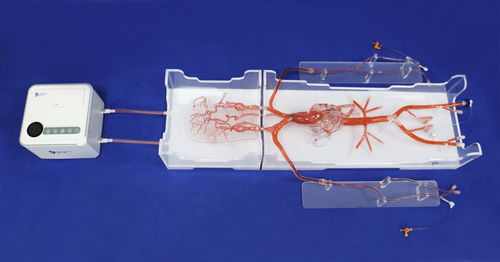
#Industry News
Carotid artery stenosis and cerebral infarction may be only one step away
Angio-interventions Training System Ⅳ
In recent years, the incidence of carotid artery stenosis has been increasing, especially among middle-aged and elderly people. Its "commonness" in inspection results does not match the degree of "emphasis" it should receive. Clinically, among the various causes of cerebral infarction, carotid artery stenosis is the most easily overlooked, but the condition often progresses rapidly. Today, let’s talk about how carotid artery stenosis forms and how to treat it.
Relevance: 30% of cerebral infarctions are caused by this
Stroke is one of the main causes of death among residents in our country. The 2019 China Stroke Prevention and Treatment Report pointed out that among stroke patients, ischemic stroke (cerebral infarction) accounts for 74%, of which about 30% of cerebral infarctions are caused by extracranial carotid artery stenosis.
Carotid stenosis is a disease in which the walls of the large arteries in the neck become narrowed. First, let’s understand how the carotid artery works in the human body. Before entering the skull, the carotid artery divides into two branches: the internal carotid artery and the external carotid artery. These two blood vessels carry blood from the heart to the brain, head, face and neck respectively.
At the point where the carotid artery divides into two branches, just like when a river divides from one into two, the sand in the river easily forms a sandbank when deposited in this part. Similarly, various cell fragments in the blood tend to deposit in this part. Plaques form. The accumulation of plaque in the blood can lead to the narrowing of blood vessels, which is clinically called "arteriosclerotic stenosis". If the plaque in the stenotic area is unstable and falls off, it will cause cerebral infarction; over time, the blood vessel will become narrower and narrower, and even completely block the blood flow, which can lead to complete occlusion of the artery, and then there will be no blood in the far end of the skull. supply, resulting in more extensive cerebral infarction.
In general, there are three main mechanisms by which carotid artery stenosis causes cerebral ischemia: first, carotid artery stenosis leads to cerebral tissue hypoperfusion (referring to a sharp decrease in microcirculatory blood perfusion in a short period of time, resulting in ischemia and hypoxia); second, Microemboli produced by plaques or thrombi falling off the surface of plaques cause cerebral vascular embolism; the third is acute vascular stenosis or occlusion caused by plaque rupture.
Treatment: To what extent does the narrowing require surgery?
The treatment of carotid artery stenosis includes non-surgical treatment and surgical treatment. Among them, surgical treatment refers to carotid endarterectomy (CEA) and carotid artery stenting (CAS).
Generally, doctors will make the following recommendations based on whether the patient has symptoms and the degree of carotid artery stenosis.
For patients with symptomatic carotid artery stenosis: ① If the carotid artery stenosis is <50%, non-surgical treatment is recommended; ② If the carotid artery stenosis is 50%-69%, priority should be given to performing carotid endarterectomy in a hospital with experience in treating carotid artery stenosis. , when the patient is at higher risk for the procedure (age >80 years, severe cardiopulmonary disease, contralateral internal carotid artery occlusion, contralateral recurrent laryngeal nerve injury, previous radical neck surgery or radiation therapy, post-CEA Recurrent carotid stenosis), carotid artery stenting is preferred; ③ carotid artery stenosis is 70%-99%; regardless of whether the patient has clinical symptoms and manifestations, carotid endarterectomy or carotid artery stent grafting is recommended Surgery; ④ When the carotid artery is completely occluded, considering the cerebral vascular reperfusion injury caused by reopening the carotid artery, non-surgical treatment is recommended. At the same time, special attention should be paid to protecting the blood supply of the contralateral carotid artery and bilateral vertebral arteries. Rely on these few unoccluded blood vessels supplying the brain to compensate.
For patients with asymptomatic carotid stenosis: ① If the carotid artery stenosis is <60%, non-surgical treatment is recommended; ② If the carotid artery stenosis is 60%-99%, carotid endarterectomy is preferred. When the patient undergoes this surgery, the risk is relatively high. When it is high, carotid artery stenting may be considered; ③ When the carotid artery is completely occluded, conservative treatment is recommended.
In conclusion, carotid stenting can be an alternative treatment to carotid endarterectomy in patients with symptomatic carotid stenosis of 50% to 99% and asymptomatic carotid stenosis of 60% to 99%. Patients at higher risk for endarterectomy may be better candidates for stenting.





